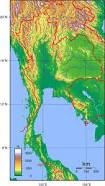
Located in the center of Southeast Asia, Thailand is truly at the heart of
the region. Looking over a map of Thailand will reveal a country whose borders
form the rough shape of an elephant’s head: the head and ears forming the mostly
landlocked northern and eastern provinces and the trunk extending down the
Malaysian peninsula between the Andaman Sea and the Gulf of Thailand.
The geography of Thailand features many natural borders with neighboring countries: a mountainous border with Myanmar (Burma) to the north and west; a long stretch of the Mekong River separating Thailand from Laos to the north and east; and the Mekong River and the Dongrak Mountains delineating the border of Cambodia to the east.
Covering an area of approximately 514,000 square kilometers (200,000 sq
miles), Thailand is the 50th largest country in the world, most
nearly equal in size to Spain. Located just 15 degrees north of the equator,
Thailand has a tropical climate and temperatures typically range from 19 to 38
degrees C (66-100 F); monsoon rains fall predominately from May to July and
cooler, drier weather occurs around November and December. Despite the
geographical boundaries of Thailand all falling within the tropics, Thailand’s
four primary regions are each geographically distinct from each other.
Along Thailand’s western border with Myanmar, the forested mountains of Thailand rise higher as they stretch north, peaking at the 2,565 meter (8,415 ft) Doi Inthanon. Thailand’s northern peaks are replete with wildlife and feature Thailand’s coolest winters.
Northeastern Thailand’s geography, where the kingdom borders Laos at the Mekong River, features the Khorat Plateau, which extends south towards the Thai border with Cambodia. The Isan region of Northeastern Thailand is the most populous region of Thailand (with the exception of Bangkok) and features a number of bustling provincial capital cities.
The geography of Thailand’s interior is dominated by the Central Plains, the “Rice Bowl of Asia,” through which the Chao Phraya River feeds expansive rice fields and then enters the bustling capital of Bangkok before spilling into the Gulf of Thailand.
Stretching down the Malaysian peninsula, the slender trunk of the figurative elephant separates the Andaman Sea from the Gulf of Thailand, providing Thailand with beaches and islands along opposing shores. Once, the sheltered coves of the narrow Isthmus of Kra were important ports along an ancient, strategic trading route; today the islands of Phuket and Koh Samui are equally important as tourist destinations, though both coasts also contain numerous historical attractions as well as national parks, wildlife sanctuaries, and spectacular forests, waterfalls, and beaches.
In addition to these natural, geographical regions, Thailand is divided into 76 political provinces, with Bangkok serving as the political, commercial, industrial, educational, and entertainment capital of the country.
The geography of Thailand features many natural borders with neighboring countries: a mountainous border with Myanmar (Burma) to the north and west; a long stretch of the Mekong River separating Thailand from Laos to the north and east; and the Mekong River and the Dongrak Mountains delineating the border of Cambodia to the east.
 |
| Thailabd |
Along Thailand’s western border with Myanmar, the forested mountains of Thailand rise higher as they stretch north, peaking at the 2,565 meter (8,415 ft) Doi Inthanon. Thailand’s northern peaks are replete with wildlife and feature Thailand’s coolest winters.
Northeastern Thailand’s geography, where the kingdom borders Laos at the Mekong River, features the Khorat Plateau, which extends south towards the Thai border with Cambodia. The Isan region of Northeastern Thailand is the most populous region of Thailand (with the exception of Bangkok) and features a number of bustling provincial capital cities.
The geography of Thailand’s interior is dominated by the Central Plains, the “Rice Bowl of Asia,” through which the Chao Phraya River feeds expansive rice fields and then enters the bustling capital of Bangkok before spilling into the Gulf of Thailand.
Stretching down the Malaysian peninsula, the slender trunk of the figurative elephant separates the Andaman Sea from the Gulf of Thailand, providing Thailand with beaches and islands along opposing shores. Once, the sheltered coves of the narrow Isthmus of Kra were important ports along an ancient, strategic trading route; today the islands of Phuket and Koh Samui are equally important as tourist destinations, though both coasts also contain numerous historical attractions as well as national parks, wildlife sanctuaries, and spectacular forests, waterfalls, and beaches.
In addition to these natural, geographical regions, Thailand is divided into 76 political provinces, with Bangkok serving as the political, commercial, industrial, educational, and entertainment capital of the country.
